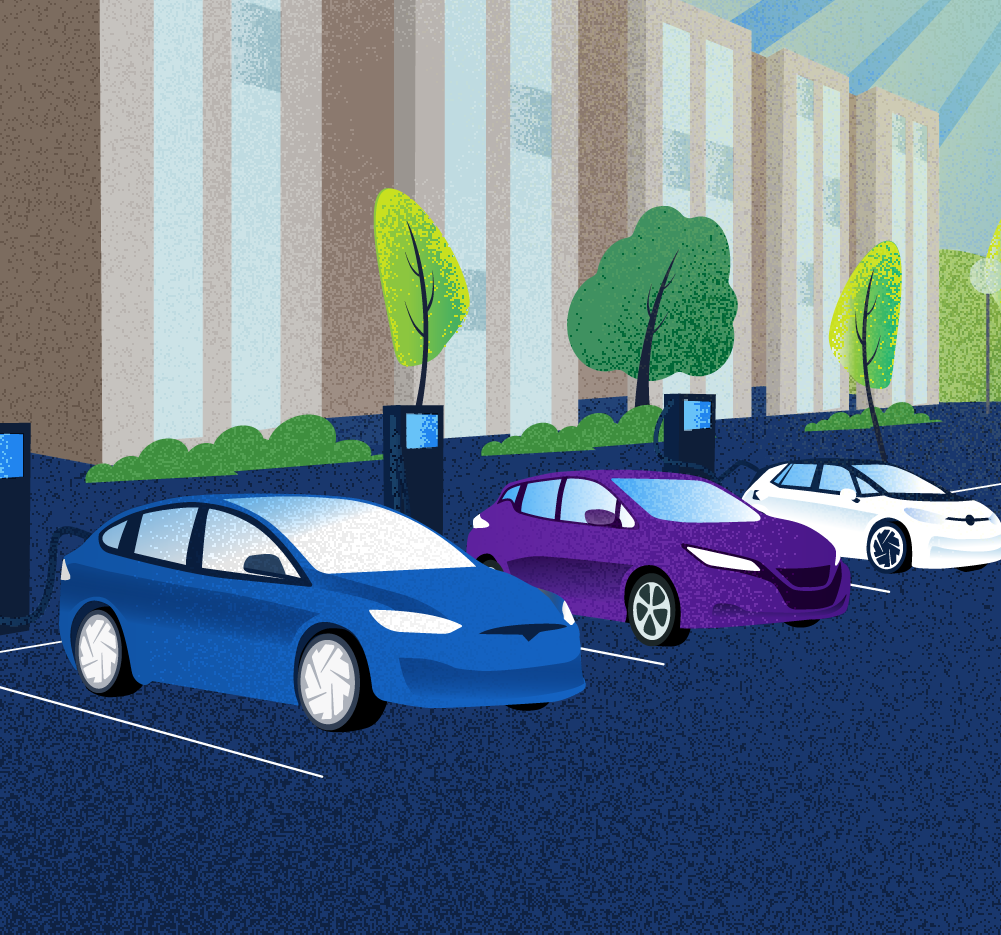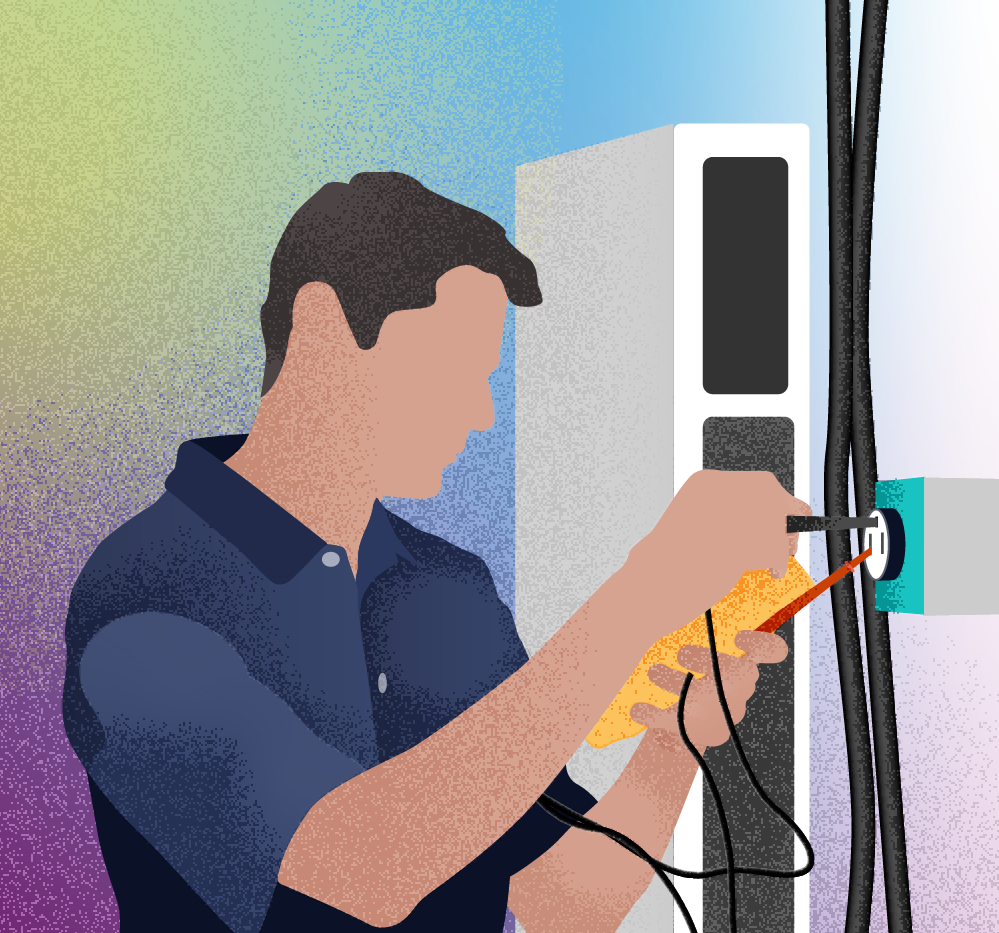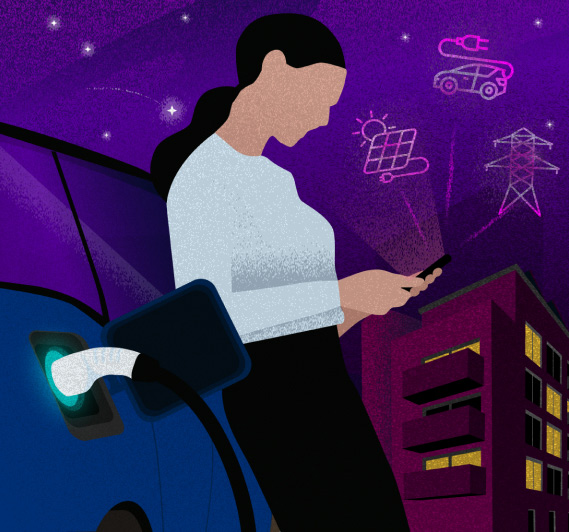It’s all around you.
Energy costs spiralling out of control.
Sustainability — no longer a “maybe” but a “must”.
Demand for EV charging — on the rise, particularly as all new vehicles in the UK will need to be electric by 2030.
You want a solution that will help people access EV charging without significant upfront investment.
So now you’re faced with complex decisions around EV charging technology, load management, billing, installations, energy supply, maintenance, and more. You’re wondering how many more steps and time the process will take. It’s a hassle to research, let alone manage it.
This guide outlines the essential steps of EV charging installation and how to make the process as sustainable, cost-effective, and seamless as possible.
The outline of a typical EV charging setup journey
Assessing Demand
The first step is assessing demand for EV charging across the apartment buildings you manage. The easiest way to do that is by surveying residents to determine
- How many of them have EVs;
- What type of EVs they drive;
- How many of those are fully electric vs hybrid;
- What their needs and preferences are regarding EV charging;
- How soon those who don’t have an EV plan to purchase one.
QUICK TIP:
As personal situation, market conditions, and regulations change, so can people’s plans and desires — all of which will affect your EV charging installation plans. It is, therefore, important to make sure you ask the right questions to get the insights you need to formulate the initial plans as well as adaptable long-term strategy.
An experienced EV charge point provider will be able to assist you in this task or even take it off your hands entirely.
Choosing Suppliers
The number of stakeholders and suppliers involved in the process can vary considerably. In most cases, you’ll be looking at:
- Certified electricians and engineers to perform an electrical audit of the building and install EV charging stations.
- Engineering firms, EV charging and energy management system (EMS) providers that may also offer electrical engineering, EV charging design and installation services.
- Electric Vehicle Supply Equipment (EVSE) providers — companies providing charging stations, electrical conductors and related equipment, as well as software. These should be compliant with the Electric vehicle smart charge points regulations. Most EVSE providers will offer process management services that may cover stakeholder communications, electrical audit, EV charging design, hardware and software installation, and maintenance.
At this point, property managers often ask, “Couldn’t I just get our trusted electrician to set everything up?” That may not be wise. And here’s why. Getting EV charging set up in an apartment building isn’t just about buying and installing the right equipment.

You also need to:
- Audit the building’s electrical plans and energy supply;
- Size capacity;
- Create strategic short- and long-term plans to prepare for different future demand and supply scenarios;
- Select and install the right technology;
Ensure ongoing hardware and software maintenance; - Make sure the entire process is cost-effective today as well as tomorrow;
and more.
QUICK TIP:
For best results, make sure the chosen electrician has experience with EV charging technology as well as EV charging infrastructure in apartment buildings.
How to choose the right supplier for you
For a truly future-proofed (and hassle free) EV charging installation, it’s best to opt for a partner that can manage the entire process for you, from EV charging strategy and securing government funding to installation, ongoing maintenance, and upgrades.
That way, you’ll not only save yourself a lot of time and effort throughout installation and future adjustments, but also ensure a smoother experience for your residents.
Characteristics of a top-quality supplier:
- The EV chargers they offer have been tested extensively and meet rigorous quality and interoperability standards
- Their solutions are compatible with different types of EVs
- They can walk you through every step of planning and execution
- They have a smart EMS that helps you manage energy usage and associated costs, as well as improve energy efficiency in your buildings
- They offer a user-friendly billing and reporting software and a clear process for selecting and managing payments
- Their approach and solutions are adaptable and tailored to your needs, even with different levels of demand across your real estate portfolio
- Their pricing is transparent — you’re given a detailed overview of the costs before, during, and after the installation, including warranty, ongoing maintenance, user app subscriptions, and EMS. (This is where a lot of hidden costs emerge — if anything sounds too good to be true, it probably is!)
Applying for government funding
Alongside a good EV charging setup strategy, including billing, and a well-paced installation plan, this is the final part of the puzzle that will help you avoid significant upfront investment.
At the moment, there are several government funding options, such as the EV chargepoint grant and EV infrastructure grant. An experienced team of EVSE providers will be able to help you unlock government funding to part-fund the work at your site.
Site inspection, legal and safety assessments
Before EV charge point installation can begin, you’ll need to check there are no issues or potential limitations that may impact the process. That includes:
- Electrical audit to assess the building’s electrical system capacity and confirm that it can handle the additional load needed for EV charging.
QUICK TIP:
Make sure the electrical audit also considers the impact of potential increase in EV charge points and other equipment.
- Thorough site inspection to analyse the physical layout of parking or other spaces where EV charging may be set up and to identify potential physical barriers that may impact access to charge points, fail to protect them from damage, or complicate the installation process.
- Identifying the best EV charging spots. Consider:
- The potential distance to power supply as it can considerably affect installation costs
- Accessibility, visibility, and convenience for EV owners
- Whether EV charging spots will be indoors or outdoors, wall-mounted or pedestal/stand-alone and the infrastructure each setup requires
- Wi-Fi access and signal strength, which will affect the use of smart energy management systems and the driver app to manage charging.
- Reviewing legal and safety requirements, such as building codes, health and safety regulations, environmental requirements, guidance on infrastructure for charging electric vehicles, and regulations on electric vehicle smart charge points.
Creating an EV charging strategy
This step is critical to finding a solution that helps you to increase property value over time and ensure fair payment options for residents. The strategy should cover:
- Initial EV charging setup and energy supply
- Adaptability to spike in demand for EV charging or changes in its configuration
- Initial investment and fair billing options, for example, spreading infrastructure costs over a set amount of time, charging people only for their share and only while they are an owner. This approach will also help secure resident buy-in for the initial EV charging setup.
- Potential additional income streams from EV charging
- How the new infrastructure will affect existing “right to park” vs allocated parking setup, particularly where it may have a negative effect on property value when EV-only parking spots are enforced. Shared parking bays vs allocated parking bays may prove to be a good solution.

QUICK TIP:
Consider how you can future-proof EV charging against variations in energy prices. It will be helpful to install or at least prepare for alternative energy sources and have a smart EMS in place.
Powerverse user app, for example, helps residents manage their charging experience by choosing when they charge their EV, receiving suggestions on cheaper and greener charging options (which include the best times for using different energy sources), as well as making sure that they only pay for what they’ve used.
Getting resident buy in
To make this process quicker and easier for everyone involved, prepare a general outline of the approach:
- Understanding demand to plan for the number of EV charging spaces over time
- Suggested investment plans and approach to installing EV charging in the building
- The government grants available and application deadlines for each
- Total budget and costs of the project
How the new setup will benefit residents and flat owners
- How those who don’t own an EV will be protected from additional expenses
- How energy supply and billing will be managed
- Measures to be taken to ensure a smooth and rapid installation process
- The process for hiring a qualified EVSE supplier
- Answers to any other concerns that may have arisen during initial assessments
That way, you’ll have covered the essentials as well as paved the way for a much smoother process for approving installation plans and signing an RMC agreement later on.
Choosing EV charging technology and setup
This stage is about three interlinked choices: charging technology, energy management system, and payment model.
Charging technology
A dedicated EV charger is always a safer option than the standard 3-pin domestic plug, as it is designed to withstand consistent loads and will not put your home at risk by overheating.
There are three types of EV-side connectors:
- Alternating Current (AC) connectors for slow/fast charging:
- Type 1
- Type 2 (most common)
- Direct Current (DC) connectors for rapid charging (less common in apartment buildings due to higher costs and energy needs):
- CHAdeMO
- Combined Charging System (CCS), the EU standard
- Type 2
On the side of the charge point, you’ll see:
- Tethered charge point with a charging cable attached, usually with both a CHAdeMO and CCS connector
- Untethered (a.k.a. universal) charge point without a cable, with either Type 2 or 3-pin plug

Energy Management system
EV charging can lead to significant incremental costs or expensive upgrades to the building’s electrical infrastructure. With a smart EMS you avoid that.
Look for an EVSE provider that offers energy and load management system that:
- Allows you to monitor energy use across buildings
- Incorporates smart load management to make sure that demand doesn’t exceed supply even when all
- charge points are connected
- Lets you control access to and use of EV charge points
- Helps residents to find the cheapest and greenest times to charge their EVs
- Allows switching between energy sources, for example, with Solar PV and residential battery storage integration
- Ideally, includes additional energy and cost optimisation functionality, such as dynamic charging, charge scheduling, and community charging
This level of EMS will also facilitate easier installation of additional charge points in the future.
Pricing models
Depending on the number of EV charge points and users, your business model, future plans, resident preferences, as well as availability and location, you may choose:
- Dynamic pricing where the cost of EV charging changes along with electricity prices. This is an optimal solution for those wishing to encourage residents to charge their EVs during off-peak hours.
- Pay-per-use when residents pay only for the electricity consumed. This model may be better suited to cover installation and maintenance costs.
- AI-managed pricing that combines different billing models, for example, by charging only per energy used and automatically starting and stopping charging as electricity costs change. Powerverse customers, for example, pay for an EV charge point only if they want it. And it’s theirs to take if they move away.
Installation
At this point, you’ll need to create and get approval of the final installation design that covers:
- Physical aspects, such as charge point location, design, and energy supply
- Technical elements:
- Changes to the electrical system, if required
- The technology selected
- Infrastructure upgrades — how those will be organised and who’s responsible
- Financial considerations, including:
- Installation costs
- Management and maintenance costs
- Software and driver app subscription, if relevant
- EMS and load management
Once the installation design has been approved and RMC agreement signed, EV charge point installation process can begin. The duration of the process can vary from a few days to weeks, depending on the number of charge points needed and the complexity of the project.
Before opening EV charging to your residents, you’ll need to submit the new infrastructure for a final inspection that examines everything from equipment to energy supply.
Ongoing maintenance
As an apartment building’s manager, it will be your responsibility to ensure that all EV charge points are in good working order. That means ongoing monitoring and maintenance, hardware and software updates, as well as seeing that any issues and resident concerns are dealt with.
To save you a lot of future headache, look into maintenance procedures and costs of EVSE suppliers before making the final choice:
- What are the typical customer service response times?
- Is maintenance part of the installation service and warranty or an add-on?
- How is it organised — is it automated and proactive or reactive, only responding to the issues logged?
Powerverse, for example, uses automatic over-the-air system updates and AI to proactively monitor all EV charge points. If an issue arises, we take action, sometimes even before your residents notice it themselves.

Driving value & cost-efficiency
Although there’s no one magic formula to EV charging success, there are ways to optimise for short- and long-term gains.
Here are four key considerations.
Future-proofing buildings and energy supply
Properties with EV charging show a 13% increase in value compared with the local average. But those are not just EV charge points that will affect real estate value and sustainability — it is your entire energy infrastructure.
To maximise the value and user experience:
- Look for a solution with flexible EV charging infrastructure. That way, you’ll be able to easily update and modify it, for example, by adding more EV charge points or installing solar panels as an alternative energy source
- Create a setup that makes it easy to monitor consumption, performance, and load management to determine when additional EV charge points are needed
- For truly environmentally friendly and cost-effective energy consumption, have a home EMS that allows you to control all electrical appliances, not just EV charge points
QUICK TIP:
Create a cadence of regular assessments of the existing EV charging infrastructure and consumption from a business perspective, its impact on property value, changes in demand and energy prices, and more.
The more automated and connected this process will be, the easier your job. For that reason, Powerverse has created an ecosystem of business apps, devices, and leading energy products that connects the energy you use, generate, or store with data on tariffs, weather forecast, and other relevant information — so you can go further with what you have (or even create new revenue streams).
Smart energy management with AI
EMS is an effective way of solving load management challenges in apartment blocks that arise with an increase in the number of EVs. But not all energy management systems are created equal.
There are EMS that:
- Provide an overview of charging data
- Let you adjust charging times
- Measure and calculate the electricity imported and exported
- Facilitate load sharing and load management
And there are smart EMS that:
- Provide granular data on EV charging (historical as well as real-time analytics)
- Give you visibility and control over the total energy consumption across appliances
- Use advanced AI to analyse this data and
- optimise energy costs for each property;
- identify and eliminate phantom loads;
- optimise energy consumption across appliances;
- switch between energy sources;
- schedule EV charging to when it’s cheapest.
If possible aim for the latter.
End-to-end service management
As it’s abundantly clear by now, setting up EV charging in apartment buildings can be a complex and time-consuming task.
Our advice? Combine as many steps as you can into one.
- A lot of the initial research can be replaced with expert consultation.
- Surveying residents, assessing demand, applying for government funding, researching and selecting the right charging technology, EMS, and electrician — an EV charge point provider that offers end-to-end process management can take all these tasks off your hands.
- Bonus points if they can also ensure ongoing hardware and software maintenance, manage the installation of additional energy sources, and provide ongoing advisory to make sure you don’t miss out on any opportunities for additional funding and better resource management in the future.
Experience and expertise
If possible, work with a provider who has considerable experience in installing EV charging in apartment blocks. This type of company will be acutely aware of your unique challenges, best practices for apartment buildings, and common mistakes to avoid.
They’ll understand your business and property portfolio and will be able tailor their offer to your needs, assist you in identifying the best approach, technology, pricing strategy, and installation design, as well as support you in making the process as cost-effective as possible.
About Powerverse
Powerverse is a smart energy management company brought to you by global solar leader, Lightsource bp. Through its work with utilities, businesses, local communities and governments, Lightsource bp is helping meet the rising demand for affordable, reliable and sustainable energy.
Our EV charging services are:
![]()
Fully managed
From pre-setup to ongoing maintenance and consulting post-installation. We don’t just install and run, we stay to make sure you get the most out of your setup. As the charging landscape evolves, so will our solution.
![]()
Tailored to your needs
With made-to-measure, per-dwelling installation options. We listen to your needs, assess demand, existing infrastructure, and practical implications to create an EV charging solution that works for your property and residents — with installation plans that keep disruption to a minimum. And we bear the big cost upfront.
![]()
Delivered by experts with years of industry experience
With decades of industry experience to draw on, our people have an in-depth understanding of the apartment market and building management. They understand the ins and outs of EV charging, alternative energy sources, and legislation. If new regulations are to be adopted or funds made available, they’ll be on top of that. And if a unique solution needs to be found, they’re the ones to turn to.
![]()
Powered by AI for maximum control, sustainability, and convenience
At the heart of the Powerverse platform sits VESTA, our AI energy expert. She analyses your goals, needs, load management, usage, and other data. With your permission, she’ll take different steps to lower the financial and environmental impact of your energy use.
![]()
Delivered through intuitive, user-friendly technology
- A driver app for residents that gives them oversight of their charging and costs.
- A partner portal for property managers and landlords that allows them to manage authentication and monitor prices and energy tariff settings.

